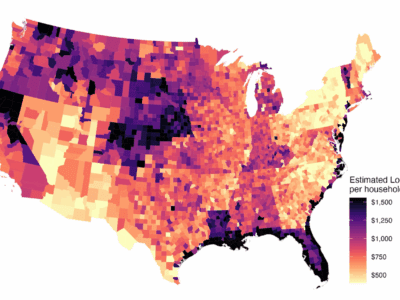Community Solar: Local and Individual Benefits
Community solar offers a rich case study for how a diverse range of values can be integrated into the traditionally narrow scope of public utility commission decision-making.

Earlier this week, I published a blog post highlighting some of the systemwide benefits community solar programs can provide and exploring considerations for policy design prioritizing each benefit. Today’s post continues that project, this time focusing on several of the benefits community solar can generate at the local or community level and for individual households: financial benefits for participants, reductions in local air pollution, and community ownership and control over renewable generation.
Financial Benefits for Participants
One of the most enthusiastically discussed benefits of community solar is the financial value projects can generate for participating ratepayers. Community solar is a concept that can be implemented many different ways to meet a range of goals and to reflect specific conditions in different states and utility territories. This makes generalizing about community solar compensation risky. Keeping in mind this variation, there are a few consistent elements with important implications for how a program financially benefits participants. These elements include how the value of community solar projects is calculated, how the resulting compensation is allocated, and who participates in the program.
Compensation for electricity from community solar, like electricity rates, is a construct of policy. Among other options, compensation can be pegged to retail rates like net metering programs, calculated based on the value of the electricity alone, or calculated to incorporate a wide range of benefits generated by community solar projects. Minnesota led the way in this space, embracing a value of solar approach back in 2014. New York, the national leader in community solar capacity, also uses a “value stack” to calculate compensation for community solar. New York’s value stack includes values for energy, capacity, demand reduction, and locational relief (is the project sited in a place where it relieves grid congestion?). Calculating compensation based on multiple attributes can help finely tune compensation to reflect the diversity of values a jurisdiction wants to encourage, like the addition of storage, siting in locations that benefit the grid overall, or various environmental benefits. (A deeper dive on compensation mechanisms to come next week.)
The allocation of the resulting compensation can vary as well. The most common model for allocating financial benefits to participating ratepayers is through credits on their electric bills. These credits can be applied in different ways and the ultimate benefit depends on how compensation nets out against electric bills and subscriber fees. One reason credits can be applied in different ways is that utilities structure their bills differently. Rates vary, of course, but so does rate design. Community solar credits can be designed to interact with the variety of charges different utilities choose to impose.
Here, I’m focusing primarily on the compensation to ratepayers, but subscription fees and other compensation paid to the owners of community solar projects have important implications as well. For private developers, compensation generally determines whether investing in community solar projects makes financial sense. Publicly-owned, non-profit, and cooperatively-owned projects meanwhile can introduce additional community-level financial benefits by reinvesting revenue into community needs. The Solar Commons Community Trust Model, for example, contemplates a common financial benefit held in trust for funding low-income weatherization, a local energy assistance program, or other community needs. Ownership decisions occur primarily at the project level, but statewide programs could be designed to better accommodate these alternative models by providing technical assistance or additional funding for non-profit or publicly-owned projects.
The last element is who participates in community solar program, and by extension, how the financial benefits of community solar are distributed. Here the important question is why generating financial benefits for participants is deemed important. Do the resulting bill reductions matter because the distribution of electric system costs is currently inequitable and costs should be spread more fairly across ratepayers as a whole? Do bill reductions matter because—as in California—there is a cost-of-living crisis and low-income people in particular need bill relief? Are any bill reductions at all desirable, regardless of how they are distributed systemwide? The answers to these questions should shape how community solar programs prioritize participation in the program, how the compensation mechanism is developed, and additional resources and technical assistance to lower the barriers to entry.
One common answer is that community solar should reduce existing disparities in the financial benefits of distributed renewable generation, which are otherwise primarily accessible to homeowners who can afford rooftop solar panels. A group of California social justice and environmental justice organizations highlighted these concerns in a 2021 letter stating their support for greater access to “community solar projects towards the goal of reaching equitable adoption targets in [Environmental Justice] communities.” Community solar programs can be designed to prioritize participation by low-income households or disadvantaged communities through explicit targets or by providing assistance in program enrollment. The letter cited above pointed to overly burdensome administrative requirements and asserted,“[t]echnical assistance offerings through third-party administrative partners, capacity-building workshops and training could help community stakeholders better engage in and apply to the program.”
Finally, in the context of financial benefits, it’s important to acknowledge that ensuring benefits starts with preventing harms. Predatory sales and marketing targeting low-income households are a longstanding concern generally and in the context of solar subscriptions. This makes consumer protection measures and compensation mechanisms crucial components of community solar program design, to the extent that affordability and bill relief goals are priorities.
Reducing Localized Air Pollution
Bundling community solar programs with building electrification is a key way community solar can reduce localized air pollution in addition to greenhouse gas emissions. Such efforts can help participating ratepayers reduce their exposure to indoor air pollution from gas appliances, as well as neighborhood-level outdoor air pollution from fossil-fired water heaters and furnaces. Reducing this pollution has major equity implications: people of color are exposed to nearly twice as much PM 2.5 pollution from residential gas appliances as compared to white people.
Community solar projects can also be tools in campaigns to accelerate the retirement of local fossil fuel generation. A given community solar project is highly unlikely to force the retirement of any specific fossil-fuel fired power plant (and therefore achieve the resulting reductions in air pollution) simply by beginning operation. This is because grid system operators conduct a range of analyses before allowing power plant retirement to ensure the system will have adequate capacity when the plant goes offline. However, communities seeking to shut down a specific fossil fuel-fired power plant could incorporate a community solar project as part of a broader concerted advocacy campaign to generate pressure highlighting the reduced need for fossil-fuel generation.
Community Ownership and Control
Community solar is often also supported on the basis that it increases community ownership and control over the electric power system. This benefit is conceptualized as empowering communities, increasing local control, and in some cases local ownership and democratic governance over the electric power system.
Increasing local ownership occurs when community members or groups own a share of a given community solar project. In practice, however, most community solar projects are neither community-owned, nor community-led; they are owned by private solar developers or utilities. Community-owned projects face several hurdles. First, utilities and private solar developers are generally more organized, well-resourced, and better able to advocate for programs that suit their business models, resulting in programs that contemplate private ownership as the default. Second, programs often include overall capacity caps, which can fill quickly with projects from better-resourced, private owners. Third, for similar reasons, community-led and community-owned projects often require technical assistance, not to mention capital, that isn’t always easy to come by. (A few community-owned models include Cooperative Energy Futures in Minnesota and the Sunset Park Solar project in New York City.)
Where the goal is community ownership, utility- and state-run programs should be responsive to these hurdles. State lawmakers that support community-owned and led community solar should contemplate legislative options to assist with the upfront capital costs and substantial technical resources required to develop these projects. (Where the priority is public ownership of new renewable generation, advocates shouldn’t sleep on the Inflation Reduction Act’s direct pay provisions, which make significant resources for a wide range of new renewable generation available to municipalities, states, tribes, and non-profits.)
Where self-governance is the primary interest, the cooperative structure is ideal. Cooperatives can be for-profit or non-profit entities. Community solar programs and projects designed to allow increased consumer choice in a marketplace, with the consumer as the primary actor, are quite distinct from a model of community solar in which the primary actor is a democratic participant with a voice in the project’s operation. There are benefits to both approaches, but where self-governance and empowerment are the goals of a community solar program, the former should not be conflated with the latter.
—
Community solar offers a rich case study for how a diverse range of values can be integrated into the traditionally narrow scope of public utility commission decision-making. The injection of these values can both enrich the conversation and heighten the complexity of balancing benefits. Determining which benefits to prioritize is a live question in fora across the country. Disagreements over the details program design played out in a community solar proceeding at the California Public Utilities Commission earlier this year and have played out in parallel debates across the country.
The variety of community solar program design options also highlights the fact that there are a wide range of other benefits that such programs could be designed to achieve—even beyond the benefits explored in these posts. Community solar is a flexible concept and both community solar programs and individual projects can be tailored to the needs of a region or community. Not every community solar project needs to actualize every possible benefit and indeed, some benefits can be in tension with one another. It may be more empowering for a community group to drive and direct the siting of their community solar project in their community, but that local decision-making may conflict with the goal of siting projects in places that make the grid more resilient or reduce the need for new infrastructure investments. These tensions heighten the importance of clarity over which benefits a given stakeholder group seeks to prioritize as they pursue community solar.
Many thanks to Brendan Wong for excellent research assistance.
Reader Comments
One Reply to “Community Solar: Local and Individual Benefits”
Comments are closed.







Thanks for sharing the nice blog.